fuel pressure OPEL CROSSLAND X 2017.75 Manual user
[x] Cancel search | Manufacturer: OPEL, Model Year: 2017.75, Model line: CROSSLAND X, Model: OPEL CROSSLAND X 2017.75Pages: 245, PDF Size: 7.6 MB
Page 74 of 245
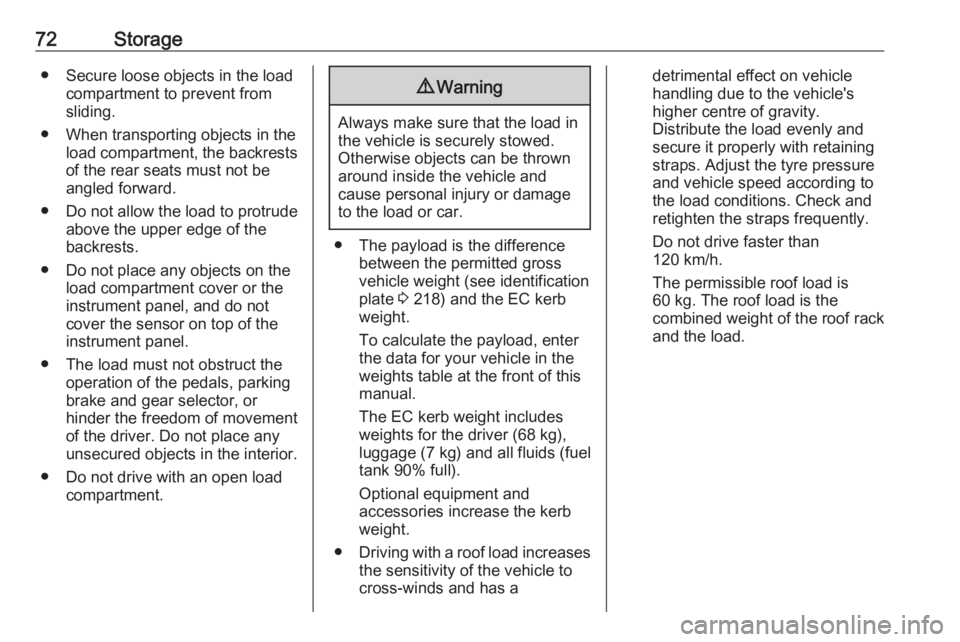
72Storage● Secure loose objects in the loadcompartment to prevent from
sliding.
● When transporting objects in the load compartment, the backrests
of the rear seats must not be
angled forward.
● Do not allow the load to protrude above the upper edge of the
backrests.
● Do not place any objects on the load compartment cover or the
instrument panel, and do not cover the sensor on top of the
instrument panel.
● The load must not obstruct the operation of the pedals, parking
brake and gear selector, or
hinder the freedom of movement of the driver. Do not place any
unsecured objects in the interior.
● Do not drive with an open load compartment.9Warning
Always make sure that the load in
the vehicle is securely stowed.
Otherwise objects can be thrown
around inside the vehicle and
cause personal injury or damage
to the load or car.
● The payload is the difference between the permitted gross
vehicle weight (see identification
plate 3 218) and the EC kerb
weight.
To calculate the payload, enter
the data for your vehicle in the
weights table at the front of this
manual.
The EC kerb weight includes
weights for the driver (68 kg),
luggage (7 kg) and all fluids (fuel
tank 90% full).
Optional equipment and
accessories increase the kerb
weight.
● Driving with a roof load increases
the sensitivity of the vehicle to
cross-winds and has a
detrimental effect on vehicle
handling due to the vehicle's
higher centre of gravity.
Distribute the load evenly and secure it properly with retaining
straps. Adjust the tyre pressure
and vehicle speed according to
the load conditions. Check and
retighten the straps frequently.
Do not drive faster than
120 km/h.
The permissible roof load is
60 kg. The roof load is the
combined weight of the roof rack and the load.
Page 75 of 245

Instruments and controls73Instruments and
controlsControls ....................................... 74
Steering wheel adjustment ........74
Steering wheel controls .............74
Heated steering wheel ...............74
Horn ........................................... 75
Windscreen wiper/washer .........75
Rear window wiper/washer .......77
Outside temperature ..................77
Clock ......................................... 78
Power outlets ............................. 78
Inductive charging .....................79
Ashtrays .................................... 79
Warning lights, gauges and indi‐ cators ........................................... 80
Instrument cluster ......................80
Speedometer ............................. 83
Odometer .................................. 84
Trip odometer ............................ 84
Tachometer ............................... 84
Fuel gauge ................................ 85
Engine coolant temperature gauge ....................................... 85
Service display .......................... 85
Control indicators ......................86Turn signal................................. 86
Seat belt reminder .....................87
Airbag and belt tensioners .........87
Airbag deactivation ....................88
Charging system .......................88
Malfunction indicator light ..........88
Service vehicle soon .................88
Stop engine ............................... 88
System check ............................ 89
Brake and clutch system ...........89
Antilock brake system (ABS) .....89
Gear shifting .............................. 89
Lane departure warning ............89
Electronic Stability Control and Traction Control system ...........90
Electronic Stability Control and Traction Control system off ......90
Engine coolant temperature ......90
Preheating ................................. 90
Diesel particle filter ....................90
AdBlue ....................................... 90
Deflation detection system ........91
Engine oil pressure ....................91
Low fuel ..................................... 91
Autostop .................................... 91
Exterior light .............................. 91
High beam ................................. 92
High beam assist .......................92
Low beam .................................. 92
Fog light ..................................... 92Rear fog light............................. 92
Rain sensor ............................... 92
Cruise control ............................ 92
Speed limiter ............................. 92
Traffic sign assistant ..................92
Door open .................................. 92
Information displays .....................93
Driver Information Centre ..........93
Info display ................................ 95
Head-up display ........................97
Vehicle messages ........................98
Warning chimes .........................99
Battery voltage .......................... 99
Vehicle personalisation ..............100
Telematics service .....................103
OnStar ..................................... 103
Page 85 of 245

Instruments and controls83OverviewOTurn signal 3 86XSeat belt reminder 3 87vAirbag and belt tensioners
3 87VAirbag deactivation 3 88pCharging system 3 88ZMalfunction indicator light
3 88HService vehicle soon 3 88STOPStop engine 3 88JSystem check 3 89RBrake and clutch system
3 89uAntilock brake system (ABS)
3 89RGear shifting 3 89)Lane departure warning
3 89bElectronic Stability Control
and Traction Control system
3 90aElectronic Stability Control
and Traction Control system
off 3 90!Preheating 3 90%Diesel particle filter 3 90YAdBlue 3 90wDeflation detection system
3 91IEngine oil pressure 3 91Y oLow fuel 3 91W oEngine coolant temperature
high 3 90DAutostop 3 918Exterior light 3 919Low beam 3 92CHigh beam 3 92fHigh beam assist 3 92>Fog light 3 92øRear fog light 3 92
Indicates vehicle speed.
Page 93 of 245

Instruments and controls91Flashes yellowThe remaining driving range is
between 0 and 600 km.
Top-up the AdBlue® as soon as
possible to avoid a breakdown by a
qualified workshop. You can add up
to 10 litres of AdBlue® to its tank.
Deflation detection system
w illuminates or flashes yellow.
Illuminates
Tyre pressure loss in one or more
wheels. Stop immediately and check
tyre pressure.
Flashes
Fault in system. Consult a workshop.
Engine oil pressure
I illuminates red.
Illuminates when the ignition is
switched on and extinguishes shortly after the engine starts.Illuminates when the engine is
runningCaution
Engine lubrication may be
interrupted. This may result in
damage to the engine and/or
locking of the drive wheels.
1. Depress clutch.
2. Select neutral gear.
3. Move out of the flow of traffic as quickly as possible without
impeding other vehicles.
4. Switch off ignition.
9 Warning
When the engine is off,
considerably more force is needed
to brake and steer.
During an Autostop, the brake
servo unit will still be operational.
Do not remove key until vehicle is stationary, otherwise the steeringwheel lock could engage
unexpectedly.
Check oil level before seeking
assistance of a workshop 3 178.
Low fuel
o illuminates yellow.
Level in fuel tank is too low.
Refuelling 3 168.
Bleeding the diesel fuel system
3 182.
Autostop
D illuminates or flashes green.
Illuminates green
Engine is in an Autostop.
Flashes green
Autostop is temporarily unavailable,
or Autostop mode is invoked
automatically.
Stop-start system 3 132.
Exterior light
8 illuminates green.
The exterior lights are on 3 107.
Page 172 of 245
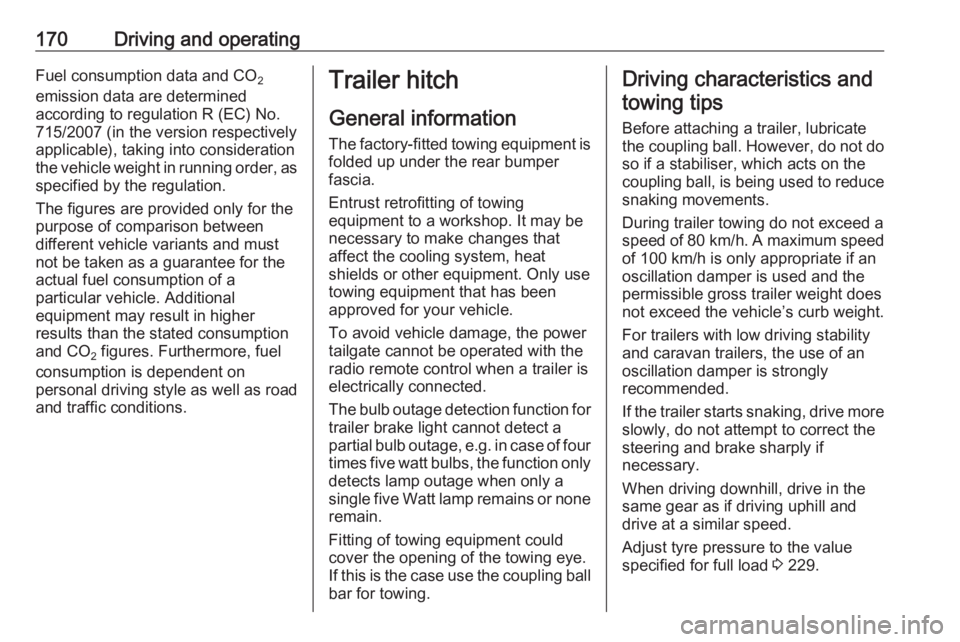
170Driving and operatingFuel consumption data and CO2
emission data are determined
according to regulation R (EC) No.
715/2007 (in the version respectively
applicable), taking into consideration
the vehicle weight in running order, as specified by the regulation.
The figures are provided only for the
purpose of comparison between
different vehicle variants and must not be taken as a guarantee for the
actual fuel consumption of a
particular vehicle. Additional
equipment may result in higher
results than the stated consumption
and CO 2 figures. Furthermore, fuel
consumption is dependent on
personal driving style as well as road
and traffic conditions.Trailer hitch
General information
The factory-fitted towing equipment is folded up under the rear bumper
fascia.
Entrust retrofitting of towing
equipment to a workshop. It may be
necessary to make changes that
affect the cooling system, heat
shields or other equipment. Only use
towing equipment that has been
approved for your vehicle.
To avoid vehicle damage, the power
tailgate cannot be operated with the
radio remote control when a trailer is
electrically connected.
The bulb outage detection function for
trailer brake light cannot detect a
partial bulb outage, e.g. in case of four times five watt bulbs, the function only
detects lamp outage when only a
single five Watt lamp remains or none remain.
Fitting of towing equipment could
cover the opening of the towing eye.
If this is the case use the coupling ball
bar for towing.Driving characteristics and
towing tips
Before attaching a trailer, lubricatethe coupling ball. However, do not do
so if a stabiliser, which acts on the coupling ball, is being used to reduce snaking movements.
During trailer towing do not exceed a
speed of 80 km/h. A maximum speed
of 100 km/h is only appropriate if an
oscillation damper is used and the
permissible gross trailer weight does
not exceed the vehicle’s curb weight.
For trailers with low driving stability
and caravan trailers, the use of an
oscillation damper is strongly
recommended.
If the trailer starts snaking, drive more
slowly, do not attempt to correct the
steering and brake sharply if
necessary.
When driving downhill, drive in the
same gear as if driving uphill and
drive at a similar speed.
Adjust tyre pressure to the value
specified for full load 3 229.
Page 177 of 245
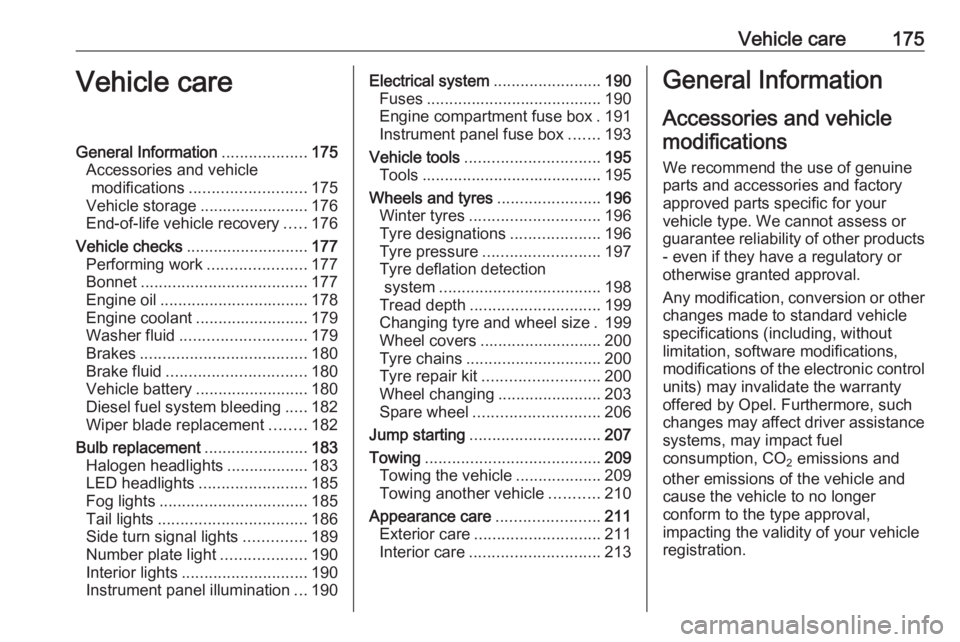
Vehicle care175Vehicle careGeneral Information...................175
Accessories and vehicle modifications .......................... 175
Vehicle storage ........................176
End-of-life vehicle recovery .....176
Vehicle checks ........................... 177
Performing work ......................177
Bonnet ..................................... 177
Engine oil ................................. 178
Engine coolant ......................... 179
Washer fluid ............................ 179
Brakes ..................................... 180
Brake fluid ............................... 180
Vehicle battery ......................... 180
Diesel fuel system bleeding .....182
Wiper blade replacement ........182
Bulb replacement .......................183
Halogen headlights ..................183
LED headlights ........................ 185
Fog lights ................................. 185
Tail lights ................................. 186
Side turn signal lights ..............189
Number plate light ...................190
Interior lights ............................ 190
Instrument panel illumination ...190Electrical system ........................190
Fuses ....................................... 190
Engine compartment fuse box . 191
Instrument panel fuse box .......193
Vehicle tools .............................. 195
Tools ........................................ 195
Wheels and tyres .......................196
Winter tyres ............................. 196
Tyre designations ....................196
Tyre pressure .......................... 197
Tyre deflation detection system .................................... 198
Tread depth ............................. 199
Changing tyre and wheel size . 199
Wheel covers ........................... 200
Tyre chains .............................. 200
Tyre repair kit .......................... 200
Wheel changing .......................203
Spare wheel ............................ 206
Jump starting ............................. 207
Towing ....................................... 209
Towing the vehicle ...................209
Towing another vehicle ...........210
Appearance care .......................211
Exterior care ............................ 211
Interior care ............................. 213General Information
Accessories and vehiclemodifications
We recommend the use of genuine
parts and accessories and factory approved parts specific for your
vehicle type. We cannot assess or guarantee reliability of other products
- even if they have a regulatory or
otherwise granted approval.
Any modification, conversion or other changes made to standard vehicle
specifications (including, without
limitation, software modifications,
modifications of the electronic control
units) may invalidate the warranty
offered by Opel. Furthermore, such
changes may affect driver assistance
systems, may impact fuel
consumption, CO 2 emissions and
other emissions of the vehicle and
cause the vehicle to no longer
conform to the type approval,
impacting the validity of your vehicle
registration.
Page 178 of 245
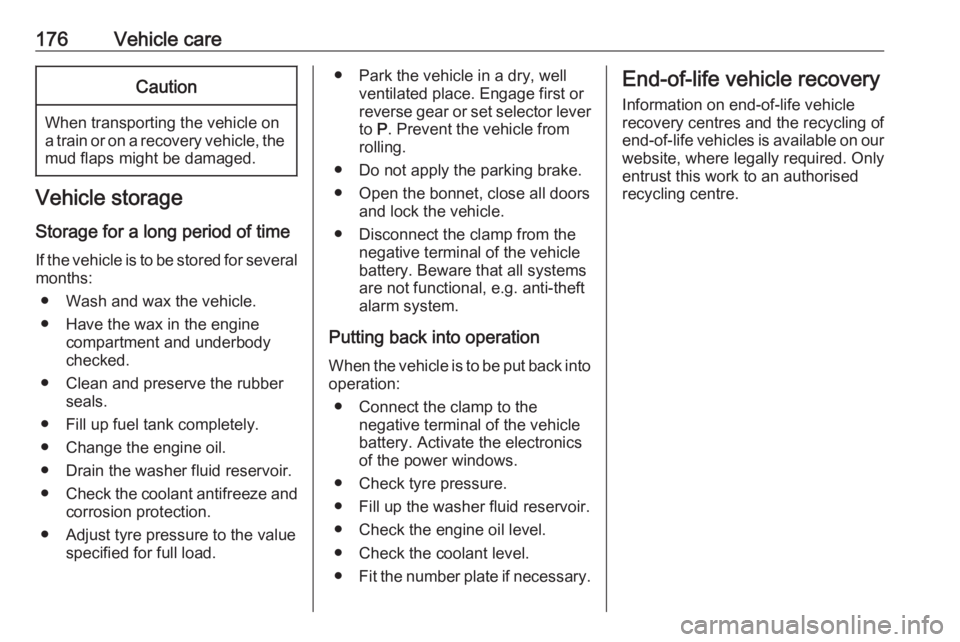
176Vehicle careCaution
When transporting the vehicle on
a train or on a recovery vehicle, the
mud flaps might be damaged.
Vehicle storage
Storage for a long period of time
If the vehicle is to be stored for several months:
● Wash and wax the vehicle.
● Have the wax in the engine compartment and underbody
checked.
● Clean and preserve the rubber seals.
● Fill up fuel tank completely.
● Change the engine oil.
● Drain the washer fluid reservoir.
● Check the coolant antifreeze and
corrosion protection.
● Adjust tyre pressure to the value specified for full load.
● Park the vehicle in a dry, wellventilated place. Engage first or
reverse gear or set selector lever
to P. Prevent the vehicle from
rolling.
● Do not apply the parking brake.
● Open the bonnet, close all doors and lock the vehicle.
● Disconnect the clamp from the negative terminal of the vehicle
battery. Beware that all systems
are not functional, e.g. anti-theft
alarm system.
Putting back into operation
When the vehicle is to be put back into
operation:
● Connect the clamp to the negative terminal of the vehicle
battery. Activate the electronics
of the power windows.
● Check tyre pressure.
● Fill up the washer fluid reservoir.
● Check the engine oil level.
● Check the coolant level.
● Fit the number plate if necessary.End-of-life vehicle recovery
Information on end-of-life vehicle
recovery centres and the recycling of
end-of-life vehicles is available on our website, where legally required. Only
entrust this work to an authorised
recycling centre.
Page 199 of 245
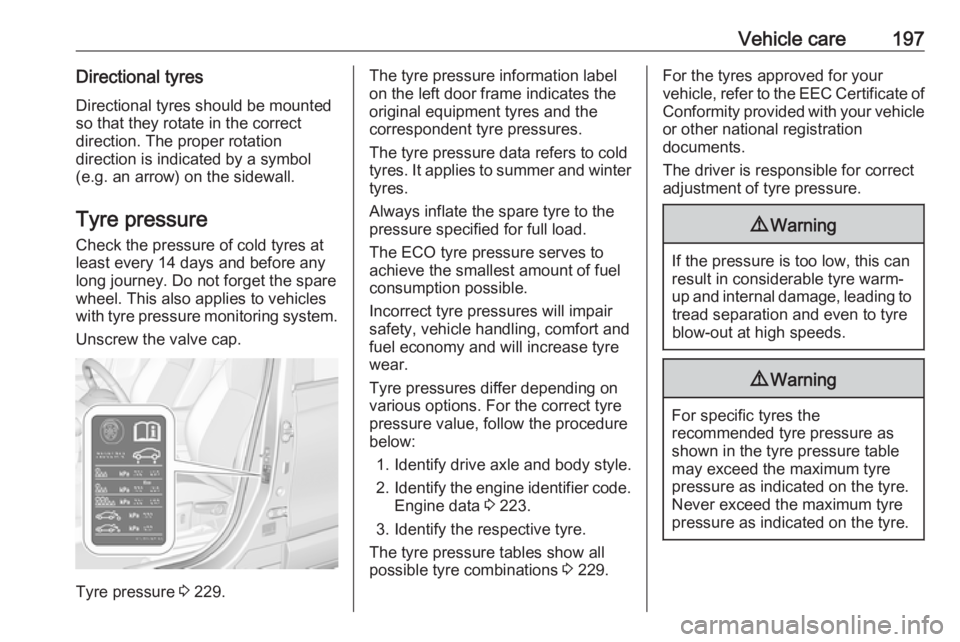
Vehicle care197Directional tyresDirectional tyres should be mounted
so that they rotate in the correct
direction. The proper rotation
direction is indicated by a symbol (e.g. an arrow) on the sidewall.
Tyre pressure
Check the pressure of cold tyres at
least every 14 days and before any
long journey. Do not forget the spare
wheel. This also applies to vehicles
with tyre pressure monitoring system.
Unscrew the valve cap.
Tyre pressure 3 229.
The tyre pressure information label
on the left door frame indicates the
original equipment tyres and the
correspondent tyre pressures.
The tyre pressure data refers to cold
tyres. It applies to summer and winter tyres.
Always inflate the spare tyre to the
pressure specified for full load.
The ECO tyre pressure serves to
achieve the smallest amount of fuel
consumption possible.
Incorrect tyre pressures will impair
safety, vehicle handling, comfort and
fuel economy and will increase tyre
wear.
Tyre pressures differ depending on
various options. For the correct tyre
pressure value, follow the procedure
below:
1. Identify drive axle and body style.
2. Identify the engine identifier code.
Engine data 3 223.
3. Identify the respective tyre.
The tyre pressure tables show all
possible tyre combinations 3 229.For the tyres approved for your
vehicle, refer to the EEC Certificate of Conformity provided with your vehicle
or other national registration
documents.
The driver is responsible for correct
adjustment of tyre pressure.9 Warning
If the pressure is too low, this can
result in considerable tyre warm-
up and internal damage, leading to tread separation and even to tyre
blow-out at high speeds.
9 Warning
For specific tyres the
recommended tyre pressure as
shown in the tyre pressure table may exceed the maximum tyre
pressure as indicated on the tyre.
Never exceed the maximum tyre
pressure as indicated on the tyre.
Page 214 of 245
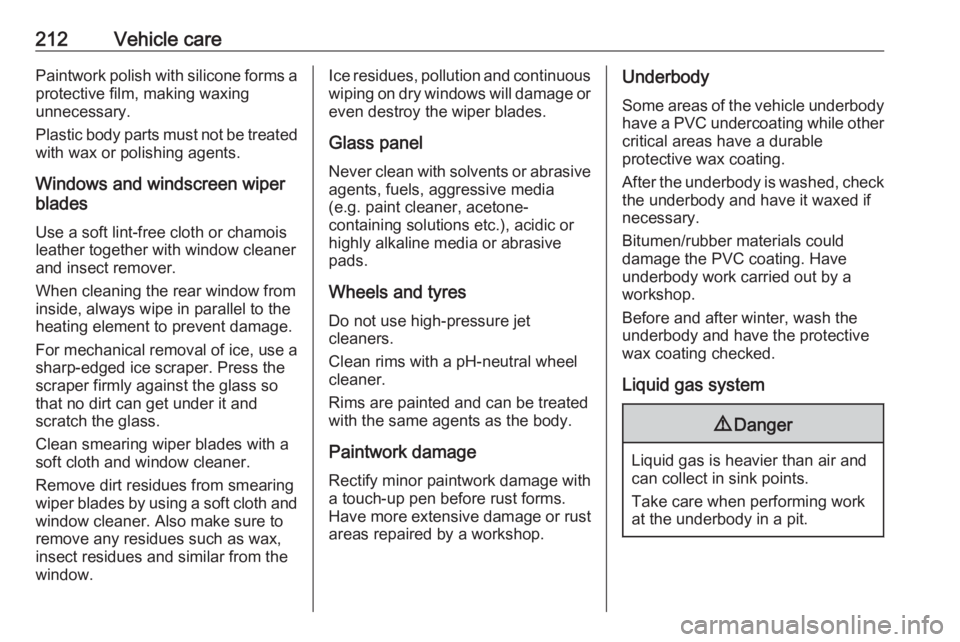
212Vehicle carePaintwork polish with silicone forms a
protective film, making waxing
unnecessary.
Plastic body parts must not be treated with wax or polishing agents.
Windows and windscreen wiper
blades
Use a soft lint-free cloth or chamois
leather together with window cleaner
and insect remover.
When cleaning the rear window from
inside, always wipe in parallel to the
heating element to prevent damage.
For mechanical removal of ice, use a
sharp-edged ice scraper. Press the
scraper firmly against the glass so
that no dirt can get under it and
scratch the glass.
Clean smearing wiper blades with a
soft cloth and window cleaner.
Remove dirt residues from smearing
wiper blades by using a soft cloth and window cleaner. Also make sure to
remove any residues such as wax,
insect residues and similar from the
window.Ice residues, pollution and continuous
wiping on dry windows will damage or even destroy the wiper blades.
Glass panel
Never clean with solvents or abrasive
agents, fuels, aggressive media
(e.g. paint cleaner, acetone-
containing solutions etc.), acidic or
highly alkaline media or abrasive
pads.
Wheels and tyres
Do not use high-pressure jet
cleaners.
Clean rims with a pH-neutral wheel
cleaner.
Rims are painted and can be treated
with the same agents as the body.
Paintwork damageRectify minor paintwork damage with
a touch-up pen before rust forms.
Have more extensive damage or rust
areas repaired by a workshop.Underbody
Some areas of the vehicle underbody
have a PVC undercoating while other
critical areas have a durable
protective wax coating.
After the underbody is washed, check
the underbody and have it waxed if
necessary.
Bitumen/rubber materials could
damage the PVC coating. Have
underbody work carried out by a
workshop.
Before and after winter, wash the
underbody and have the protective
wax coating checked.
Liquid gas system9 Danger
Liquid gas is heavier than air and
can collect in sink points.
Take care when performing work
at the underbody in a pit.
Page 241 of 245
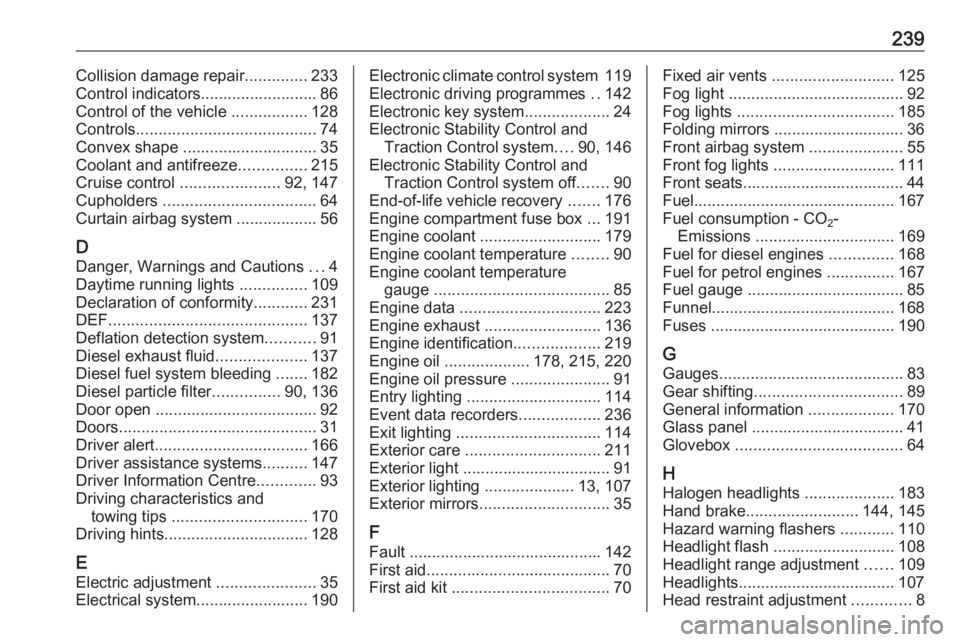
239Collision damage repair..............233
Control indicators.......................... 86
Control of the vehicle .................128
Controls ........................................ 74
Convex shape .............................. 35
Coolant and antifreeze ...............215
Cruise control ...................... 92, 147
Cupholders .................................. 64
Curtain airbag system .................. 56
D
Danger, Warnings and Cautions ...4
Daytime running lights ...............109
Declaration of conformity ............231
DEF ............................................ 137
Deflation detection system ...........91
Diesel exhaust fluid ....................137
Diesel fuel system bleeding .......182
Diesel particle filter ...............90, 136
Door open .................................... 92
Doors ............................................ 31
Driver alert .................................. 166
Driver assistance systems ..........147
Driver Information Centre .............93
Driving characteristics and towing tips .............................. 170
Driving hints ................................ 128
E Electric adjustment ......................35
Electrical system......................... 190Electronic climate control system 119
Electronic driving programmes ..142
Electronic key system ...................24
Electronic Stability Control and Traction Control system ....90, 146
Electronic Stability Control and Traction Control system off .......90
End-of-life vehicle recovery .......176
Engine compartment fuse box ...191
Engine coolant ........................... 179
Engine coolant temperature ........90
Engine coolant temperature gauge ....................................... 85
Engine data ............................... 223
Engine exhaust .......................... 136
Engine identification ...................219
Engine oil ................... 178, 215, 220
Engine oil pressure ......................91
Entry lighting .............................. 114
Event data recorders ..................236
Exit lighting ................................ 114
Exterior care .............................. 211
Exterior light ................................. 91
Exterior lighting ....................13, 107
Exterior mirrors ............................. 35
F
Fault ........................................... 142
First aid ......................................... 70
First aid kit ................................... 70Fixed air vents ........................... 125
Fog light ....................................... 92
Fog lights ................................... 185
Folding mirrors ............................. 36
Front airbag system .....................55
Front fog lights ........................... 111
Front seats.................................... 44
Fuel............................................. 167
Fuel consumption - CO 2-
Emissions ............................... 169
Fuel for diesel engines ..............168
Fuel for petrol engines ...............167
Fuel gauge ................................... 85
Funnel......................................... 168
Fuses ......................................... 190
G Gauges ......................................... 83
Gear shifting ................................. 89
General information ...................170
Glass panel .................................. 41
Glovebox ..................................... 64
H
Halogen headlights ....................183
Hand brake ......................... 144, 145
Hazard warning flashers ............110
Headlight flash ........................... 108
Headlight range adjustment ......109
Headlights................................... 107 Head restraint adjustment .............8